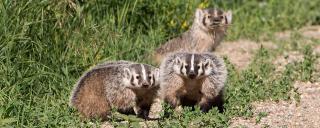 |
| Fact Sheet |
| Scientific Name |
Taxidea taxus |
| Description |
Badgers have a flattened, stocky body with a bushy tail. They are wider than they are tall. Black and white stripes run vertically down the face with a dorsal white stripe extending from the nose down the back. Their back and sides have long fur tinged gray, red or yellow, and their feet are dark brown or black. Distinctive long claws, up to 2 inches in length, assist in digging their many burrows. |
Tracks |
Badger tracks: Front track significantly larger than rear. Front–3-1/2" L, 2" W Rear–2-1/2" L, 1-3/4" W Walking stride: 5-1/2" - 9-3/4" |
| Total Length |
20-35 inches |
| Weight |
9-26 pounds |
| Habitat |
Badgers are found throughout North Dakota, but are most abundant on the prairies. |
| Breeding Season |
July-September. Fertilized eggs then delay implantation for 7 months. |
| Gestation Period |
42 days |
| Litter Size |
1-5 (average 2) |
| Social Aspects |
Badgers are solitary, except when breeding or rearing young. |
| Status |
Badgers are common in North Dakota and have a year-round open season. |
| Food Habits |
Badgers are carnivorous, eating primarily small rodents such as ground squirrels, voles and moles. Additionally, badgers will eat mice, rabbits, eggs, birds, reptiles and insects. |
| Fun Facts |
Badger fur is used for making high-quality paint brushes. However, their fur does not become prime until late winter. During summer, badgers will dig a new den almost every night to rest in during the day, and they rarely reuse the same den twice. |


